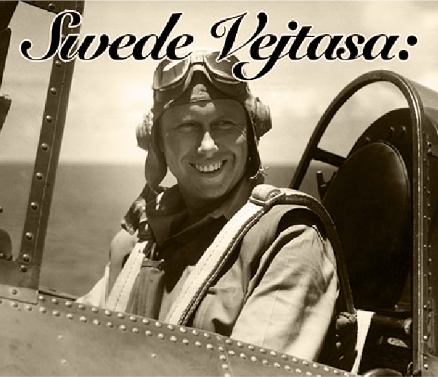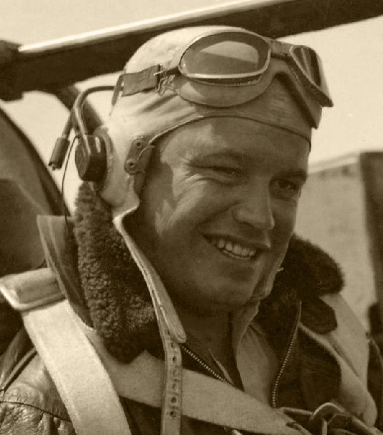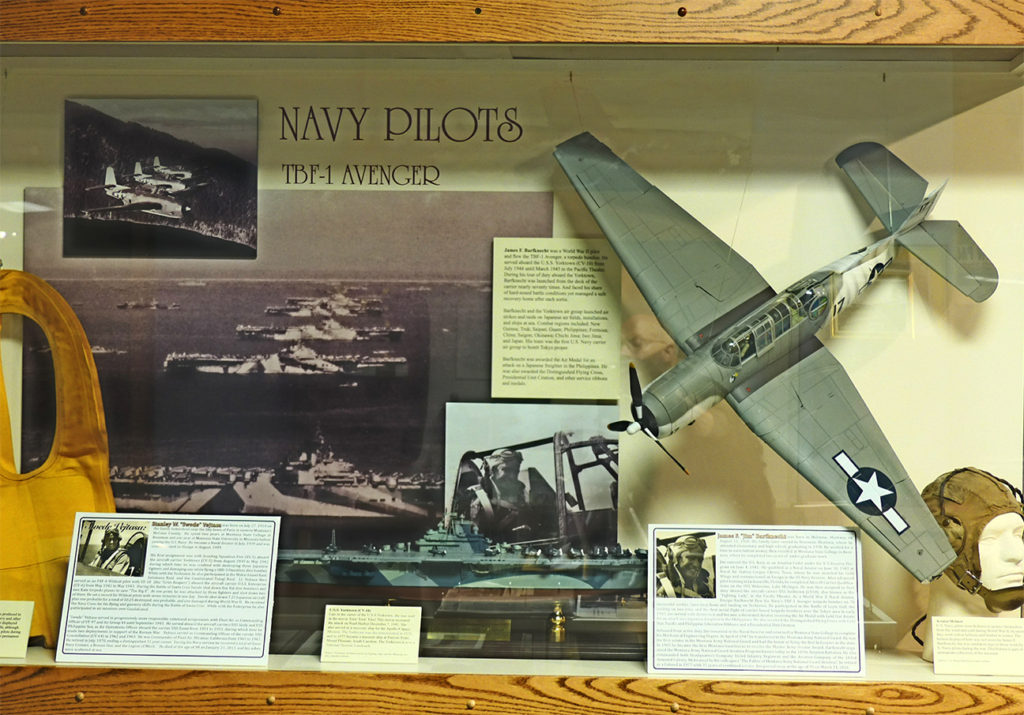Naval Air Exhibit

Stanley W. "Swede" Vejtasa
Swede Vejtasa was born on July 27, 1914 on the family homestead near the tiny town of Paris in eastern Montana’s McCone County. He spent two years at Montana State College at Bozeman and one year at Montana State University in Missoula before joining the U.S. Navy. He became a Naval Aviator in July, 1939 and was commissioned an Ensign in August, 1939.
His first assignment was with Scouting Squadron Five (VS-5) aboard the aircraft carrier Yorktown (CV-5) from August 1939 to May 1942 during which time he was credited with destroying three Japanese fighters and damaging one while flying an SBD-3 Dauntless dive bomber.
While with the Yorktown, he also participated in the Makin Island Raif, Salamaua Raid, and the Guadalcanal-Tulagi Raid. Lieutenant Vejtasa then served as an F4F-4 Wildcat pilot with VF-10 (the “Grim Reapers”) aboard the aircraft carrier U.S.S. Enterprise (CV-6) from May 1942 to May 1943. During the Battle of Santa Cruz Swede shot down five Val dive bombers and two Kate torpedo planes to save “The Big E.” At one point, he was attacked by three fighters and shot down two of them. He set a record for Wildcat pilots with seven victories in one day. Swede shot down 7.25 Japanese aircraft plus one probable for a total of 10.25 destroyed, one probable, and one damaged during World War II. He received the Navy Cross for his flying and gunnery skilling during the Battle of Santa Cruz. While with the Enterprise he also participated in air missions over Guadalcanal.
“Swede” Vejtasa served in progressively more responsible command assignments with Fleet Air, as Commanding Officer of VF-97 and AirGroup 44 until September 1945. He served aboard the aircraft carriers USS Sicily and USS Philippine Sea, as Air Operations Officer aboard the carrier USS Essex from 1951 to 1953, during which time he made two deployments in support of the Korean War. Vejtasa served as Commanding Officer of the career USS Constellation (CV-64) in 1962 and 1963. He was Commander of Fleet Air, Miramar, California from 1965 to 1967. He retired in July, 1970, ending a distinguished 31 year career. During his Navy Service he received a total of three Navy Crosses, a Bronze Star, and the Legion of Merit. He died at the age of 98 on January 23, 2013 and his ashes were scattered at sea.

James F. "Jim" Barfknecht
James F. “Jim” Barfknecht was born in Melstone, Montana on August 21, 1920. His family later moved to Bozeman, Montana, where he attended elementary and high school, graduating in 1938. He worked for a time to earn tuition money, then enrolled at Montana State College in Bozeman, where he completed two years of under graduate work.
Jim entered the U.S. Navy as an Aviation Cadet under the V-5 Reserve Program on June 4, 1942. He qualified as a Naval Aviator on June 30, 1943 at Naval Air Station Corpus Christi, Texas, where he was awarded his Gold Winds and commissioned an Ensign in the US Navy Reserve. After advanced pilot training in Jacksonville, Florida, he completed Aircraft Carrier Qualifications on the USS Wolverine, Lake Michigan. He was then assigned to fleet duty aboard the aircraft carrier USS Yorktown (CV10), also known as the “Fighting Lady”, in the Pacific Theater.
As a World War II Naval Aviator, Ensign Barfknecht flew the Navy’s TBF-1 Avenger torpedo bomber on 70 successful sorties, launching from a landing on Yorktown. He participated in the Battle of Leyte Gulf, the landing on Iwo Jima, and the first aerial flight of carrier-based torpedo bombers over the Tokyo area in early 1945. Jim served with distinction and became a decorated Aviator, receiving the Air Medal with Gold Star Asiatic for an attack on a Japanese freighter in the Philippines. He also received the Distinguished Flying Cross with Gold Star, Pacific and Philippine Liberation Ribbons and a Presidential Unit Citation.
Released from active duty, Jim remained in the Naval Reserve and returned to Montana State College to complete his Mechanical Engineering Degree. In April 1947 he transferred to the Montana Army National Guard. He was the first aviator in the Montana Army National Guard and had the honor of flying the first helicopter in the state. In 1964 he became the first Montana Guardsman to receive the Master Army Aviator Award. Barfknecht organized the Montana Army Nation Guard Aviation Program known today as the 189th Aviation Battalion. He also commanded both Headquarters Company 163rd Infantry Regiment and the Aviation Company of the 163rd Armored Calvary. Nicknamed by his colleagues “The Father of Montana Army National Guard Aviation”, he retired as a Colonel in 1977 with 35 years of combined service. Jim passed away at the age of 95 on March 24, 2016.


